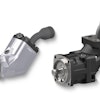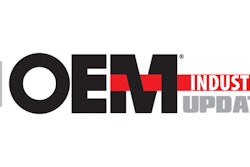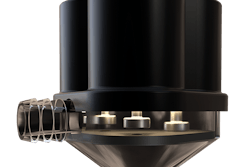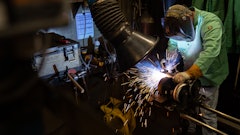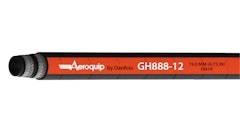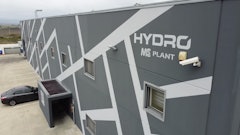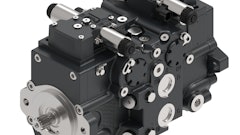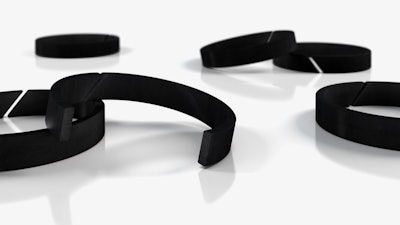
There are few places where highly durable, temperature resistant, chemically compatible, low maintenance parts are more important than in off-highway vehicles.
After all, the vehicle in question might end up in the Australian Outback enduring 130 F (54.4 C) temperatures, in Siberia traveling through snow at -60 F (51.1 C), or in a mining operation where sulfuric acid could severely compromise a polymer-based guide ring. Additionally, maintaining off-highway vehicles in extreme conditions is a challenge that means low-maintenance, long-life parts can be the difference between hitting a deadline or missing it.
High-modulus thermoplastics offer a solution to many of the issues faced by designers of hydraulic systems for off-highway applications. Modulus is a mechanical property that measures the elasticity of a material; the higher the modulus, the more stress, or force, is required to deform or compress the material.  High-modulus solid bearings with grease grooves.Trelleborg Sealing Solutions
High-modulus solid bearings with grease grooves.Trelleborg Sealing Solutions
Base polymers and fillers
Of the three main groups of high-modulus plastics, semicrystalline thermoplastics offer the most affordable materials appropriate for processing into guide rings, bearings, back-up rings, and structural components (the other two groups being amorphous thermoplastics and imidized materials).
Within semicrystalline thermoplastics, several base polymers are commonly used in extruded parts for use in off-highway hydraulic systems:
- Polyamide (PA or Nylon)
- Polyphthalamide (PPA)
- Polyetheretherketone (PEEK)
- Polyoxymethyline (POM or acetal)
- Ultra-high-molecular-weight polyethylene (UHMW-PE)
These polymers vary in terms of temperature resistance, tensile strength, flexural modulus (bending stiffness), Izod impact (toughness/resistance to impact), and chemical resistance. For example, while PEEK materials are extremely strong and temperature resistant, UHMW-PE is tough and abrasion resistant.
A number of fillers are used to add strength or modify the tribological effects of thermoplastics in this category. Adding a polytetrafluoroethylene (PTFE) powder to the pellets used in injection molding can lessen friction and improve the wear characteristics of PEEK materials. Molybdenum disulfide (moly) can be added to nylon to create a harder and more wear-resistant surface.
Both glass and carbon fibers can be added to thermoplastics to add strength. A common example is adding glass to PA to enhance strength and reduce the amount of water the final product will absorb. Similarly, adding carbon fiber to a PEEK material helps increase the wear properties to extend the life of a guide ring in high-temperature applications.
Generally speaking, the higher the temperature resistance and strength of a thermoplastic in this category, the higher the cost. For example, PEEK materials are extremely strong (operating stress of up to 11,000 psi [758.4 bar]) and can resist temperatures up to 450 F (232.2 C). However, this high performance comes at a cost. For some applications, the additional cost is well worth it; for others, it may make sense to use a POM (acetal), UHMW-PE, or a PA with a filler such as glass.
| Thermoplastic Material | Temperature Rating | Chemical Resistance | Moisture Absorption Rate |
| PEEK | 450 F (232.2 C) | Excellent | 0.1% |
| PPA | 300 F (148.9 C) | Excellent/good | 0.35% |
| PA | 200 F (93.3 C) | Good/fair | 1.6% |
| POM | 180 F (82.2 C) | Fair/poor | 0.15% |
| UHMW-PE | 180 F (82.2 C) | Excellent | 0.01% |
Product types
Products that can be created from the base materials described above include guide rings, bearings/bushings, back-up rings, and structural components.
In all cases, the high-modulus plastic versions of these parts are considerably lighter than their metal counterparts. Individually, the weight difference is negligible, but changing out components used in multiple locations within a piece of equipment can considerably lessen weight. For example, the shoe pad used in four to six locations within a forklift, which is traditionally made of cast steel, can be replaced by a glass-filled nylon version that can withstand the same impact and load as the steel component at 1/6th the weight.
Additionally, high-modulus plastic rings are capable of being modified to include internal lubricants, enabling them to be used in systems that don’t require the use of petroleum-based greases and are more environmentally friendly.
 High-modulus material can be utilized for structural and wear components.Trelleborg Sealing Solutions
High-modulus material can be utilized for structural and wear components.Trelleborg Sealing Solutions
Looking forward
Co-injection molding is one technology of interest for those designing hydraulic systems for off-highway use. This allows two polymers to be combined in a single operation to create multiple functions in one component. A good example is an elastomeric material that acts as a seal and a scraper combined with a stronger thermoplastic material that acts as a bushing or guide ring. This component would be an ideal molded rod end in a hydraulic cylinder used in the excavator bucket of an off-highway vehicle, for instance.
Although the technology for these types of operations exists, it can be challenging for designers to understand the applications in which it can be used most effectively. Working closely with a manufacturer that has expertise in co-injection molding is a good first step in discovering how to take advantage of innovative part designs.


